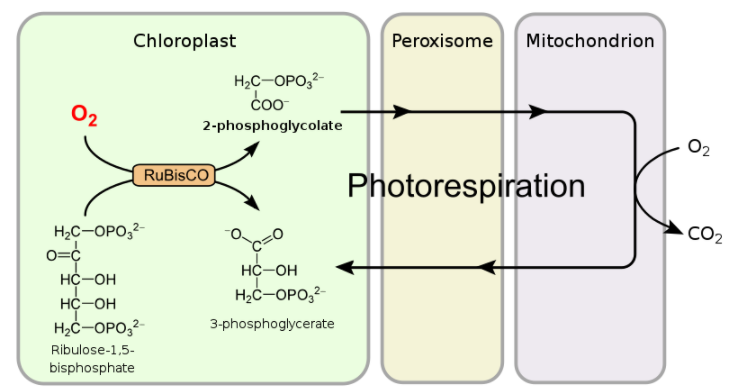
Photorespiration is favoured by A. Low light and high $O_2$
B. Low $O_2$ and high $CO_2$
C. Low temperature and high $CO_2$
D. High $O_2$ and low $CO_2$
Answer
555.3k+ views
Hint: In this process oxidation of RuBisCo enzyme takes place and oxygenates into RuBP, here some of the energy is wasted which was produced during photosynthesis. That is why it is known as a wasteful pathway.
Complete answer:
Photorespiration is favoured by the high oxygen and low carbon dioxide conditions. During the Calvin cycle, the enzyme RuBisCo attaches to carbon dioxide and starts producing sugar through different stages of the Calvin cycle. But sometimes when the concentration of oxygen is higher than carbon dioxide then the RuBisCo attaches to the oxygen instead of carbon dioxide. This causes the beginning of photorespiration. During the process of photorespiration carbon dioxide is released and also energy is utilized. So we can say photorespiration wastes energy and decreases the synthesis of sugar as it releases carbon dioxide utilized for the sugar production. It is also known as the C$_2$cycle. It is initiated in chloroplast but it occurs in peroxisomes.
Rate of photorespiration is increased by: -When stomata are closed to prevent water loss, the amount of oxygen gas increases and carbon dioxide decreases. -An increase in temperature causes the inability to recognize oxygen or carbon dioxide by RuBisCo and also reduces the solubility of carbon dioxide that results in decreased carbon dioxide concentration.

Hence, the correct answer is option (D).
Note: Rubisco makes up 30% or more of the soluble protein in a typical plant leaf ribulose-1, 5-bisphosphate (RuBP). Photorespiration is also known as C$_2$cycle. It begins in chloroplast but occurs in peroxisomes. Photorespiration increases with an increase in temperature. Photorespiration does not produce any ATP and leads to a net loss of carbon and nitrogen as a result of plant growth.
Complete answer:
Photorespiration is favoured by the high oxygen and low carbon dioxide conditions. During the Calvin cycle, the enzyme RuBisCo attaches to carbon dioxide and starts producing sugar through different stages of the Calvin cycle. But sometimes when the concentration of oxygen is higher than carbon dioxide then the RuBisCo attaches to the oxygen instead of carbon dioxide. This causes the beginning of photorespiration. During the process of photorespiration carbon dioxide is released and also energy is utilized. So we can say photorespiration wastes energy and decreases the synthesis of sugar as it releases carbon dioxide utilized for the sugar production. It is also known as the C$_2$cycle. It is initiated in chloroplast but it occurs in peroxisomes.
Rate of photorespiration is increased by: -When stomata are closed to prevent water loss, the amount of oxygen gas increases and carbon dioxide decreases. -An increase in temperature causes the inability to recognize oxygen or carbon dioxide by RuBisCo and also reduces the solubility of carbon dioxide that results in decreased carbon dioxide concentration.

Hence, the correct answer is option (D).
Note: Rubisco makes up 30% or more of the soluble protein in a typical plant leaf ribulose-1, 5-bisphosphate (RuBP). Photorespiration is also known as C$_2$cycle. It begins in chloroplast but occurs in peroxisomes. Photorespiration increases with an increase in temperature. Photorespiration does not produce any ATP and leads to a net loss of carbon and nitrogen as a result of plant growth.
Recently Updated Pages
Why are manures considered better than fertilizers class 11 biology CBSE

Find the coordinates of the midpoint of the line segment class 11 maths CBSE

Distinguish between static friction limiting friction class 11 physics CBSE

The Chairman of the constituent Assembly was A Jawaharlal class 11 social science CBSE

The first National Commission on Labour NCL submitted class 11 social science CBSE

Number of all subshell of n + l 7 is A 4 B 5 C 6 D class 11 chemistry CBSE

Trending doubts
Differentiate between an exothermic and an endothermic class 11 chemistry CBSE

10 examples of friction in our daily life

One Metric ton is equal to kg A 10000 B 1000 C 100 class 11 physics CBSE

Difference Between Prokaryotic Cells and Eukaryotic Cells

State the laws of reflection of light

Explain zero factorial class 11 maths CBSE




